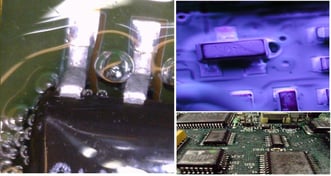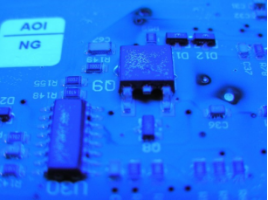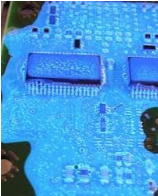
"Have you ever experienced air entrapment in your conformal coating? We would like to offer some assistance to help you to get rid of those exasperating bubbles in the conformal coating process.

Contrary to what most people think bubbles are not material related, bubbles are mostly caused by process related issues. Yes, it is true that the conformal coating contents would influence in having more or less bubbles. Solvents will definitively generate bubbles if the process is not properly set but that is not all! You have to think about several other factors that could negatively affect the result of your coating application in regards of bubbles.
So, we will talk about not one, but three clever techniques to reduce and/or get rid of the bubbles.
First of all, we need to identify clearly the characteristics of your conformal coating:
- Solids Content: Conformal coatings would normally include the “main resin”, additives and solvents. Solvents eventually will disappear in to the atmosphere when curing. The less solids content the coating has, the more solvents it contains. Thus, more solvents could mean more possibilities of generating bubbles.
- Solvent Type: Solvent vapor evaporation rate will affect bubble formation. Sometimes the solution lays in the combination of solvents used and oven profiles. Since there are many combinations of these variables, contact us to help you with thinner selection.
- Curing recommendations: Regularly, the product manufacturer would include some recommendation on how to cure the material. Whether you should cure it at RT (room temperature), heat to accelerate or through a chemical reaction, it is important to know and understand all these recommendations. For example: curing too fast may generate bubbles by trapping solvent vapor under the coating surface.
- Viscosity: You might think “why is viscosity relevant for bubbles?”. Well, let’s put it this way, you’ll find out by reading this post!
Now, let’s identify the type of problem you have:
- Small bubbles. They are all over the board. They make the coating look like sparkling water; sometimes the bubbles are great in number that they can form a foam.


- Big bubbles. Usually near large components. Typically this is a sign of solvent or air escaping from underneath the component but gets trapped before it can escape the coating surface.

Where do you see them first?
- Right after or during the application with the coating system?
- After the curing process.
- Have you seen bubbles in the conformal coating pot?
You have to be aware that the bubbles could be generated from very different parts in the system.
First, the pressure pot. Normally, the coating system uses a pressurized pot where the coating is pushed through the hoses and connections up to the valve by air pressure. If this pressure is too high, you could actually mix “residual air” in to the coating. If this happens, the bubbles would rise as soon as this pressure is released. When does this happens? Right away after the coating is dispensed through the valve. How do you know if the air is mixed with the coating? This is hard to detect at first sight. If you open the pot, you will see a clean and bubble free liquid. Using a stainless steel spatula or a viscosity cup gently stir the coating. If the coating contains dissolved air, disturbing the liquid will generate small bubbles similar to a sparkling soda! To avoid this, make sure that:
- You reduce the air pressure used in the tank. Remember, try to use only the minimum required to have a constant flow through your coating system.
- Make sure that the coating level inside the pot never reaches below 35%.
- Don’t leave the pot pressurized when not in use for more for more than 12 hrs. Simply release excess gas from the pressure pot when not in use.
- And last but not least, if you are using a solvent free conformal coating (UV's and some silicones), you can always ask your supplier if they have bladder bag packaging. You’ll need small changes to your system, but you could forget about bubbles in the pot!
Application of conformal coatings plays an important role in avoidance of bubble formation. In our experience, it is hard to generalize this problem, as a majority of the time this happens with spray and film coating. The reason why it’s really specific for this applications is because they both use additional pressure to properly work. For instance, spraying needs assisted air in the tip of the nozzle to atomize the coating. The higher the pressure you use, the more atomization you will obtain. But, if you go too high on assisted air pressure and you dispense too close to the substrate, you can generate a lot of “micro-turbulence” and some bubbles may appear. Film coating is the same, in order to have a constant fan width you need certain pressure always present in the nozzle. Too close to the substrate and too high in the fluid pressure and you could generate bubbles. To avoid this, just try to improve your coating programs by increasing the distance between the substrate and the tip of the nozzle; or reduce the assisted pressure. This could take some time and programming skills, but the result would be worth the effort.
In summary, bubble formation depends on the coating type, solvent used in the coating, application methods, and set up parameters. Please feel free to contact us for more help or information at www.humiseal.com/contact-us.
Email question: Rafael Hernandez






